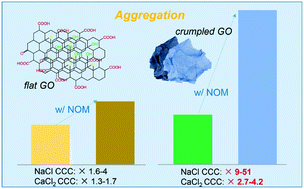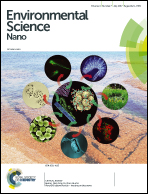Graphene oxides in water: assessing stability as a function of material and natural organic matter properties†
Abstract
Interactions with natural organic matter (NOM) are critical to consider when evaluating the stability of nanoscale materials, including graphene oxide (GO), in aquatic environments. However, such understanding has been confounded by the physical and chemical complexities of both NOM and GO materials. In this work, the aggregation kinetics of three GO material types, with varied geometries and surface chemistries (one flat and two crumpled, denoted as CGO), were investigated and compared in the presence of two salts (NaCl and CaCl2) and three model NOMs (Suwannee River humic acid, Suwannee River fulvic acid, and Aldrich humic acid (SRHA, SRFA, and AHA)). While the presence of NOM is observed to considerably increase the critical coagulation concentrations (CCC) for all GO materials evaluated, the stability enhancement for CGO is at least one order of magnitude higher than that of flat GO, regardless of surface chemistry. This augmented stability is primarily due to enhanced steric repulsion via adsorbed NOM, although electrostatic repulsion also plays a role in the case of highly reduced GO (e.g., CGO-800). NOM with higher (net) aromaticity was also correlated with increased (relative) stability enhancements (AHA > SRHA > SRFA > no HA in the presence of NaCl), suggesting π–π interactions likely play a key role in interaction mechanisms, which is similar to previous reports describing carbon nanotube–NOM interactions, and confirmed by FTIR analysis. Further, based on adsorption results, higher adsorption density of NOM on crumpled surfaces likely contribute to higher CCC of CGOs. In summary, this report elucidates complex interactions between GO material properties (morphology, surface chemistry, etc.) and NOM characteristics (e.g., aromaticity) with regard to aqueous stability – which is crucial to fundamentally understand towards a predictive framework for describing GO fate in real-world systems.

- This article is part of the themed collection: Sustainable Nanotechnology Organization


 Please wait while we load your content...
Please wait while we load your content...